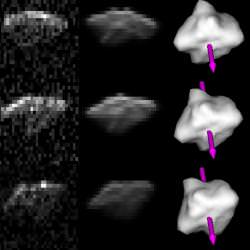 Astronomers have theorized that light from the Sun influences the speed at which asteroids spin, and now they’ve gathered the evidence to back it up.
Astronomers have theorized that light from the Sun influences the speed at which asteroids spin, and now they’ve gathered the evidence to back it up.
The “Yarkovsky-O’Keefe-Radzievskii-Paddack” (YORP) effect proposed that when sunlight strikes an asteroid’s surface, it warms the region up slightly. As the heat is radiated away, there’s a recoil effect that causes the asteroid to spin. It’s not a lot, but added up over millions of years, it can really set an asteroid spinning.
Now astronomers have found this effect in action on nearby asteroid 2000 PH5. They watched the asteroid using a variety of instruments across the Earth over the course of 4 years. During this period, they were able to measure an increase in its rotation speed. Although it takes 12 minutes to complete one rotation, that period is decreasing by 1 millisecond a year.
They calculated that over the next 35 million years, the rotation period will drop to 20 seconds, and it might end up spinning so fast that it reshapes itself or breaks apart.
Original Source: ESO News Release
